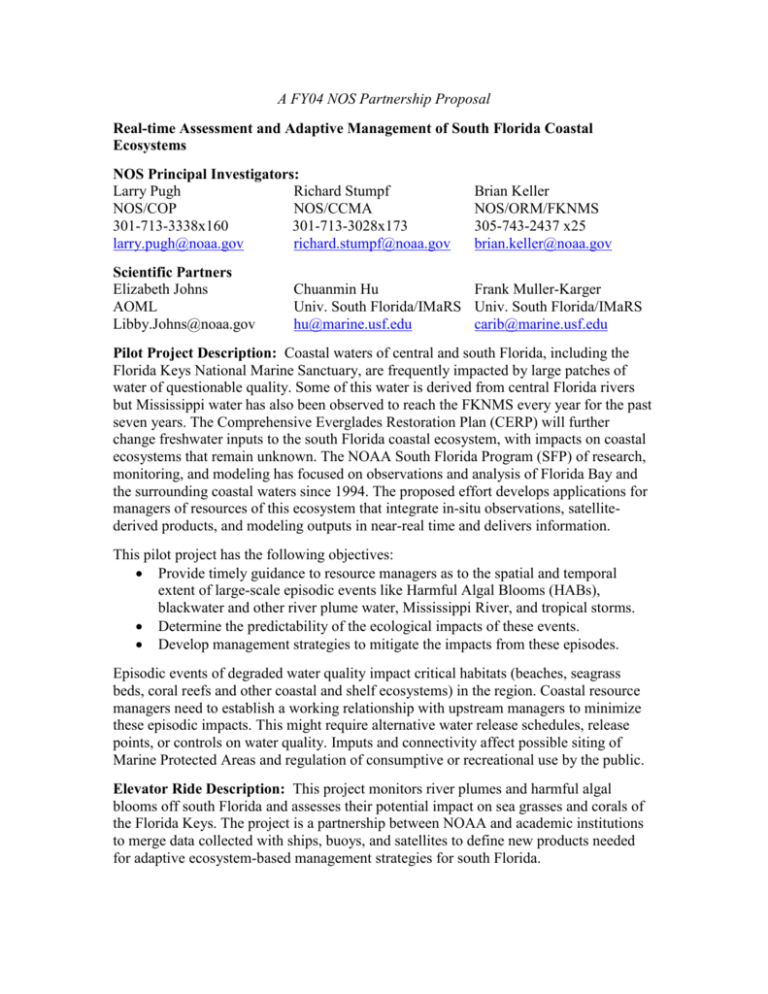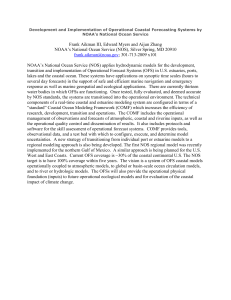Applications (Internal and External Collaborators)
advertisement

A FY04 NOS Partnership Proposal Real-time Assessment and Adaptive Management of South Florida Coastal Ecosystems NOS Principal Investigators: Larry Pugh Richard Stumpf NOS/COP NOS/CCMA 301-713-3338x160 301-713-3028x173 larry.pugh@noaa.gov richard.stumpf@noaa.gov Scientific Partners Elizabeth Johns AOML Libby.Johns@noaa.gov Brian Keller NOS/ORM/FKNMS 305-743-2437 x25 brian.keller@noaa.gov Chuanmin Hu Frank Muller-Karger Univ. South Florida/IMaRS Univ. South Florida/IMaRS hu@marine.usf.edu carib@marine.usf.edu Pilot Project Description: Coastal waters of central and south Florida, including the Florida Keys National Marine Sanctuary, are frequently impacted by large patches of water of questionable quality. Some of this water is derived from central Florida rivers but Mississippi water has also been observed to reach the FKNMS every year for the past seven years. The Comprehensive Everglades Restoration Plan (CERP) will further change freshwater inputs to the south Florida coastal ecosystem, with impacts on coastal ecosystems that remain unknown. The NOAA South Florida Program (SFP) of research, monitoring, and modeling has focused on observations and analysis of Florida Bay and the surrounding coastal waters since 1994. The proposed effort develops applications for managers of resources of this ecosystem that integrate in-situ observations, satellitederived products, and modeling outputs in near-real time and delivers information. This pilot project has the following objectives: Provide timely guidance to resource managers as to the spatial and temporal extent of large-scale episodic events like Harmful Algal Blooms (HABs), blackwater and other river plume water, Mississippi River, and tropical storms. Determine the predictability of the ecological impacts of these events. Develop management strategies to mitigate the impacts from these episodes. Episodic events of degraded water quality impact critical habitats (beaches, seagrass beds, coral reefs and other coastal and shelf ecosystems) in the region. Coastal resource managers need to establish a working relationship with upstream managers to minimize these episodic impacts. This might require alternative water release schedules, release points, or controls on water quality. Imputs and connectivity affect possible siting of Marine Protected Areas and regulation of consumptive or recreational use by the public. Elevator Ride Description: This project monitors river plumes and harmful algal blooms off south Florida and assesses their potential impact on sea grasses and corals of the Florida Keys. The project is a partnership between NOAA and academic institutions to merge data collected with ships, buoys, and satellites to define new products needed for adaptive ecosystem-based management strategies for south Florida. Project Application: Ecosystem and resource management tools that integrate 1) in-situ oceanographic observations and models and 2) satellite/remote sensing for . Oceanographic observations/Numerical Model Activities (AOML and UM/RSMAS) NOTE: These activities build upon ongoing NOS supported observations and modeling. Expand present moored real-time observing system with one critical site and incorporate key optical water quality observations. Run HYCOM model to evaluate specific upstream management scenarios, project possible impacts for adaptive downstream management scenarios, to guide field studies and interpret satellite products (see below). Deploy applications via the South Florida Program site (www.aoml.noaa.gov/sfp/). Satellite/Remote Sensing Activities: (CCMA and USF) CCMA will establish the requirements of managers (state, local, tribal, and federal) for specific products, delivery mechanisms, etc. CCMA, in partnership with USF, will characterize historic patterns and trends observed in satellite imagery. Jointly with the AOML and USF, CCMA will a validation strategy for the following products: Time series of satellite imagery, climatologies (monthly, seasonal, annual) and anomalies for turbidity and estimated light attenuation (1985–present). Identify areas on the reef that were most frequently impacted by turbidity events. Examine the potential interaction between sea surface temperature (SST) and other water quality problems as stressors to corals. The effort would be done to complement the CREWS program, in a partnership aimed to examine possible improvements in the NESDIS global Hot Spot bleaching forecast program. Address real-time requirements of ecosystem managers preparing for hurricanes. USF will work with CCMA to demonstrate new water quality assessment products derived from MODIS high resolution and fluorescence bands. These will help identify blackwater and river plume events and chlorophyll and turbidity anomalies. Specifically: Daily water turbidity and clarity images to support seagrass and hardbottom (coral) monitoring programs. Improve SST products using multiple sensors to minimize cloud cover problems. Produce benthic cover maps based on Landsat images for use in GIS applications. Target User Groups: Resource managers of south Florida, including but not limited to: tribal governments, local county governments, Florida FWCC; Florida DEP, South Florida Water Management District (SFWMD), NOS/FKNMS and BNP, ENP, and DTNP and their advisory panels; Army Corps of Engineers. Applications (Internal and External Collaborators) Web-based tools for data interpretation and synthesis, and to generate information required for management of resources. Satisfy requirements of users of the NOAA HAB Forecast System. Assess CERP water management scenarios and their downstream impacts. Provide guidance as to Marine Protected Area (and control region) siting. Provide guidance as to changes in consumptive or recreational public use. Provide real-time guidance to the research community. Strategic Alignment: This partnership aligns with NOAA’s 2007 Guidance to 1) use advanced data assimilation techniques, and 2) use in-situ and remotely sensed data for routine environmental prediction and forecasting of the extent and impact of critical ecosystem events as well as the effects of human activities. The project also addresses partnerships with educational institutions and it develops cohesive programs that promote environmental literacy. It supports NOAA Strategic Plan Goal Numbers 2.1, 3.1 and 3.2. NOS Partners: NOS/COP will provide overall program development, oversight, and PI coordination (at no cost). NOS/CCMA will work with USF to develop remote sensing products. NOS/FKNMS will assist in product identification, evaluation and optimization and in the development of science-based adaptive management strategies. External Partners: AOML and UM/RSMAS will improve moored real-time and shipboard observations to validate remote sensing products and oceanographic models. USF will develop MODIS-based high resolution water quality remote sensing products. NOS Integration: This project joins NOS/COP supported South Florida efforts, NOS remote sensing, and FKNMS coral reef resource management expertise to address management requirements, and to develop products for transition to operations. Implementation Details: Timeline and deliverables: Year 1: Enhance moored platforms and add one station; develop prototype of MODIS products; derive turbidity and attenuation monthly mean time series (1985-1995), GIS seagrass imagery (1998-2005), and statistical analysis of satellite and in-situ SST. Year 2: Derive turbidity, attenuation and algal pigment means and anomalies through 1996, seagrass GIS products for 2006; derive products that identify reef areas threatened by turbidity; assess potential interaction between water quality and SST as stressors. Year 3: Develop seagrass GIS products for 2007; ensure a system is in place to satisfy ongoing requirements for scientific information by managers in the region including FKNMS; train region managers in use of applications. Costs by FY and by budget class: (in $K) Year 1 AOML salaries 200 Equipt 65 CCMA equipt 10 Travel 2 Contracts 70 USF salaries 80 Year 2 165 5 Year 3 165 5 2 70 150 2 60 150






